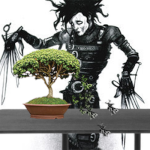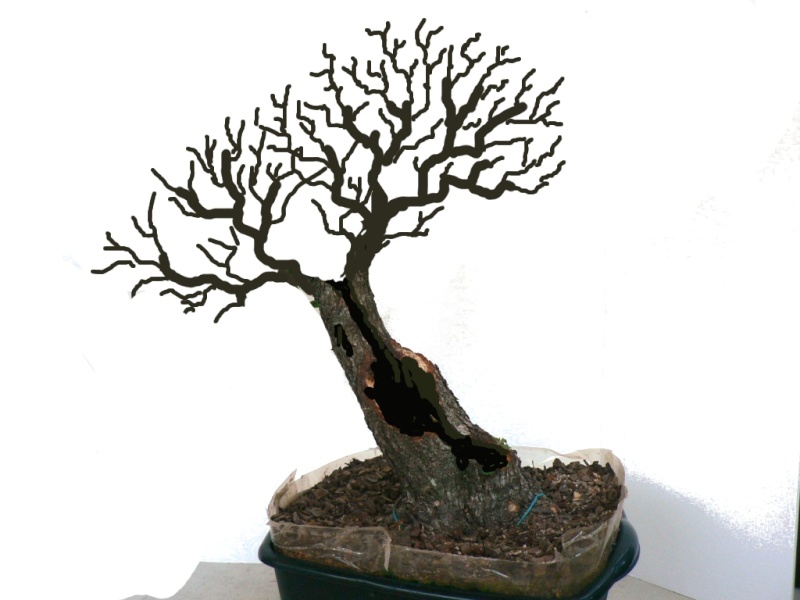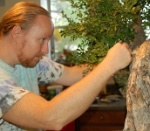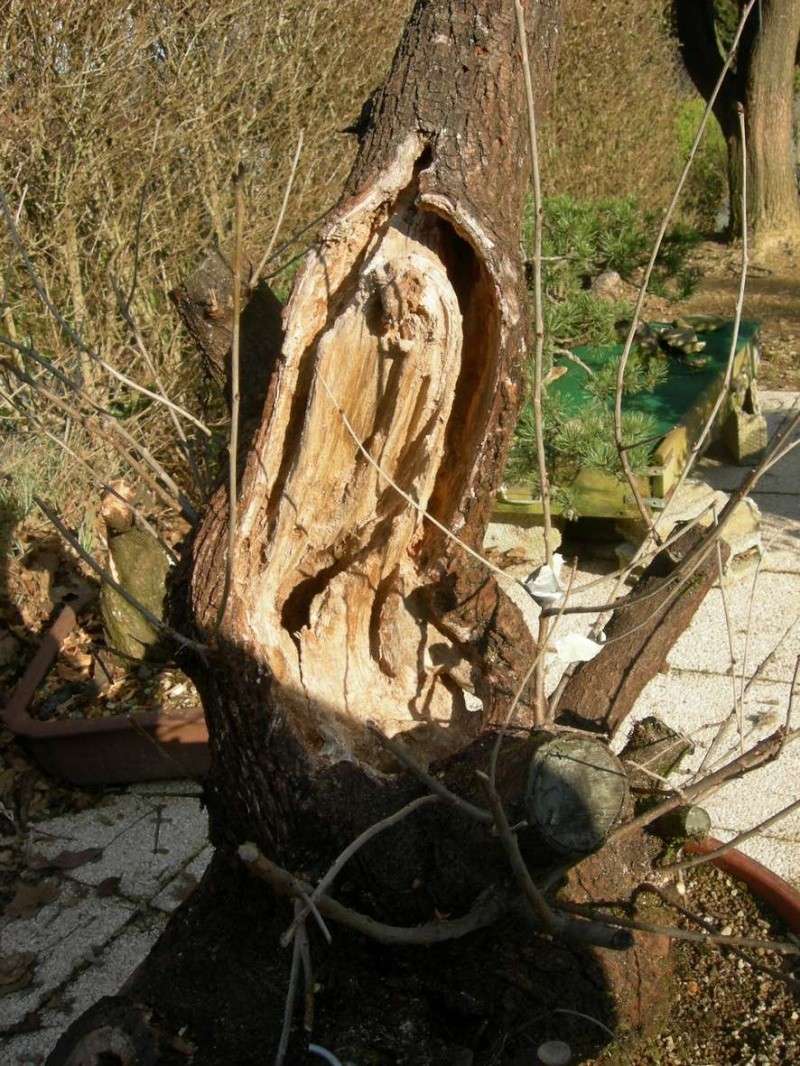Deadwood carving help please.
+4
Treedwarfer
JimLewis
marcus watts
Poink88
8 posters
Page 1 of 1
 Deadwood carving help please.
Deadwood carving help please.
I just surrendered and accepted that I am not a carving artist.  I have all the tools I need but I have no vision how to make a nice deadwood feature. (Will B., remember what I said, it is not the tools but the artist?). That said, I am still hoping it will come in time.
I have all the tools I need but I have no vision how to make a nice deadwood feature. (Will B., remember what I said, it is not the tools but the artist?). That said, I am still hoping it will come in time.
A month ago, I am on leave (for 2 weeks to baby sit my daughter) and have nothing to do (dangerous)... I chopped one of my larger collected cedar elm (from 2 main branches down to one). It looks better now IMHO but the chop is awful and I do not know how to proceed. Somehow, I can copy and critique, but not create. I played with it a bit and not sure if I made it worse by limiting my future options or not. The engineer in me stops my creative side to take the reigns on this...it is forcing the smaller chop footprint over irregular & artistic deadwood. GRRRR I have an ugly heart shaped chop now that I know have to be changed drastically but have to stop before I make it worse until I get some guidance.
I have an ugly heart shaped chop now that I know have to be changed drastically but have to stop before I make it worse until I get some guidance.
I watched tons of Graham Potter's video, looked at lots of deadwood pics online but still nothing!!!
I will post pics later but for now I am semi venting (frustrated of myself) and maybe/hopefully get some advise later.
EDIT: Here are some pics:
Front.

Back.

Current deadwood closeup.

Thank you.
A month ago, I am on leave (for 2 weeks to baby sit my daughter) and have nothing to do (dangerous)... I chopped one of my larger collected cedar elm (from 2 main branches down to one). It looks better now IMHO but the chop is awful and I do not know how to proceed. Somehow, I can copy and critique, but not create. I played with it a bit and not sure if I made it worse by limiting my future options or not. The engineer in me stops my creative side to take the reigns on this...it is forcing the smaller chop footprint over irregular & artistic deadwood. GRRRR
I watched tons of Graham Potter's video, looked at lots of deadwood pics online but still nothing!!!
I will post pics later but for now I am semi venting (frustrated of myself) and maybe/hopefully get some advise later.
EDIT: Here are some pics:
Front.

Back.

Current deadwood closeup.

Thank you.
Last edited by Poink88 on Fri Aug 17, 2012 7:45 pm; edited 1 time in total

Poink88- Member
 Re: Deadwood carving help please.
Re: Deadwood carving help please.
This is the tree in question (from this thread https://ibonsaiclub.forumotion.com/t9861-ulmus-crassifolia-cedar-elm-1-tree-progression-poink88?highlight=poink88 ).
I removed the taller main branch on the front. I will post current pic later today or early tomorrow.

I removed the taller main branch on the front. I will post current pic later today or early tomorrow.


Poink88- Member
 Re: Deadwood carving help please.
Re: Deadwood carving help please.
hi Dario
my green bits are better than the white bits too, so i sat practicing on chunks of wood that are not attached to pots and roots.
what soon became obvious was using a little hook to lift fibres and pliers to tear them off gave much better results than power tools when creating the surface texture. A scalpel blade made more realistic cracks and grooves too, so i just use electic tools for making hollows now and hand tools that worl 1mm at a time for the rest.
if you have really large chopped off broadleaf trees often the fully hollow trunk look is the most realistic you can get as well.
cheers Marcus
my green bits are better than the white bits too, so i sat practicing on chunks of wood that are not attached to pots and roots.
what soon became obvious was using a little hook to lift fibres and pliers to tear them off gave much better results than power tools when creating the surface texture. A scalpel blade made more realistic cracks and grooves too, so i just use electic tools for making hollows now and hand tools that worl 1mm at a time for the rest.
if you have really large chopped off broadleaf trees often the fully hollow trunk look is the most realistic you can get as well.
cheers Marcus

marcus watts- Member
 Re: Deadwood carving help please.
Re: Deadwood carving help please.
Poink88 wrote:I just surrendered and accepted that I am not a carving artist.I have all the tools I need but I have no vision how to make a nice deadwood feature. (Will B., remember what I said, it is not the tools but the artist?). That said, I am still hoping it will come in time.
A month ago, I am on leave (for 2 weeks to baby sit my daughter) and have nothing to do (dangerous)... I chopped one of my larger collected cedar elm (from 2 main branches down to one). It looks better now IMHO but the chop is awful and I do not know how to proceed. Somehow, I can copy and critique, but not create. I played with it a bit and not sure if I made it worse by limiting my future options or not. The engineer in me stops my creative side to take the reigns on this...it is forcing the smaller chop footprint over irregular & artistic deadwood. GRRRRI have an ugly heart shaped chop now that I know have to be changed drastically but have to stop before I make it worse until I get some guidance.
I watched tons of Graham Potter's video, looked at lots of deadwood pics online but still nothing!!!
I will post pics later but for now I am semi venting (frustrated of myself) and maybe/hopefully get some advise later.
Thank you.
i suspect you have a terribly evolved left brain half...that is typical for scientists...and engineers. The left brain is where artistrry and creativity comes from :-)
Well, the first thing you have to do is stop reosoning ;-) No seriously, this takes a bit of time. Time to feel confident, not be afraid of 'the beast' you so desperately want to tame. You cant carve if you have fear and reason in your mind :-). Maybe it would help not to look for any more graham potter videos. What i sometimes do is just think about places in nature i've been where i saw these old weathered trees and think about all the drama those trees have. Fear leaves my hands quickly then, and i just try to get the drama out of the tree
enough poetry now
Guest- Guest
 Re: Deadwood carving help please.
Re: Deadwood carving help please.
It depends on what you want to do.
I don't know which of those 2 branches you removed, so that adds to my problem, but . . .
1. If you want to "heal" the chop so it won't be noticeable at some point in the distant future, you can SLIGHTLY hollow the chop site, and promote the bark to grow over the chop over the years. You probably will have to scuff up the callus every year to promote further growth into and over the bare wood. It sometimes helps to take the smallest router bit on a Dremel tool and route out a (again) slightly deeper channel around the edge of the chop -- both now and in the future when you scuff the callus. Different folks do it differently.
2. If the chop is to be part of the ultimate design -- a hollow in the trunk, or part of a shari -- it takes a bit more thought. One of the basic things to remember when designing these, however, is to not have smooth, even edges to the deadwood feature. Ma Nature is careless that way. Her artistic designs have uneven, ragged (LOOKING) edges. That's not to say that you don't carefully clean away scraps of bark or slivers of wood from the edges and center of the deadwood area. So, "heart-shaped" is not in the tree's future.
As has been mentioned earlier, power tools aren't necessarily the things to use when creating a large area of deadwood as part of the design. They leave pretty obvious tracks. Xacto knives are useful. Woodworkers chisels can be (except when in MY hands!) helpful. For shari, a chisel to get things started, then a pair of pliers to roll the chiseled start down the trunk however long you want it to be works best for me. I'm sure others have other methods. Finish the edges with the Xacto knife, let it dry (totally), then finish and polish it with a wire brush on your Dremel or whatever you have.
And look at trees in nature with damaged trunks. Those things are probably easier to find in bonsai than in nature, but if you use bonsai for a model, choose appropriate ones. Kimura's immensely popular twisties are not the models to learn from -- at least not now.
Good luck -- and practice -- on a tree you're not totally wild about -- or even a dead one.
I don't know which of those 2 branches you removed, so that adds to my problem, but . . .
1. If you want to "heal" the chop so it won't be noticeable at some point in the distant future, you can SLIGHTLY hollow the chop site, and promote the bark to grow over the chop over the years. You probably will have to scuff up the callus every year to promote further growth into and over the bare wood. It sometimes helps to take the smallest router bit on a Dremel tool and route out a (again) slightly deeper channel around the edge of the chop -- both now and in the future when you scuff the callus. Different folks do it differently.
2. If the chop is to be part of the ultimate design -- a hollow in the trunk, or part of a shari -- it takes a bit more thought. One of the basic things to remember when designing these, however, is to not have smooth, even edges to the deadwood feature. Ma Nature is careless that way. Her artistic designs have uneven, ragged (LOOKING) edges. That's not to say that you don't carefully clean away scraps of bark or slivers of wood from the edges and center of the deadwood area. So, "heart-shaped" is not in the tree's future.
As has been mentioned earlier, power tools aren't necessarily the things to use when creating a large area of deadwood as part of the design. They leave pretty obvious tracks. Xacto knives are useful. Woodworkers chisels can be (except when in MY hands!) helpful. For shari, a chisel to get things started, then a pair of pliers to roll the chiseled start down the trunk however long you want it to be works best for me. I'm sure others have other methods. Finish the edges with the Xacto knife, let it dry (totally), then finish and polish it with a wire brush on your Dremel or whatever you have.
And look at trees in nature with damaged trunks. Those things are probably easier to find in bonsai than in nature, but if you use bonsai for a model, choose appropriate ones. Kimura's immensely popular twisties are not the models to learn from -- at least not now.
Good luck -- and practice -- on a tree you're not totally wild about -- or even a dead one.

JimLewis- Member
 Re: Deadwood carving help please.
Re: Deadwood carving help please.
How about a picture of the tree in its current state?
Treedwarfer- Member
 Re: Deadwood carving help please.
Re: Deadwood carving help please.
Thanks guys!!! 
Jim, the branch I removed is the one shown in the front (see 2nd post), leaving a heart shaped chop near the middle of the (now) shorter remaining tree. I plan on using the deadwood as a feature since I don't think the cut will heal over the almost 3" wide cut.
Jim, the branch I removed is the one shown in the front (see 2nd post), leaving a heart shaped chop near the middle of the (now) shorter remaining tree. I plan on using the deadwood as a feature since I don't think the cut will heal over the almost 3" wide cut.

Poink88- Member
 Re: Deadwood carving help please.
Re: Deadwood carving help please.
Don't know how long you've had this tree, but in some cases it helps to just let the exposed wood rot for a time, instead of trying to work it all at once. Allowing some natural decay into the process can show you where to go as the tree stabilizes in the years after collection.
With this tree, I'd look at that large left sub trunk as a candidate for some future carving...The whole sub trunk might work as a "broken off" limb feature, instead of a living portion of the tree...
FWIW, cedar elm isn't all that terrific at holding onto deadwood. It also tends to produce thick rolling scar tissue that can close over detailed carving in a few years...
With this tree, I'd look at that large left sub trunk as a candidate for some future carving...The whole sub trunk might work as a "broken off" limb feature, instead of a living portion of the tree...
FWIW, cedar elm isn't all that terrific at holding onto deadwood. It also tends to produce thick rolling scar tissue that can close over detailed carving in a few years...
rockm- Member
 Re: Deadwood carving help please.
Re: Deadwood carving help please.
The new photos remind me a bit of my pear trunk (in this thread). Earlier this year I noted ants digging into the trunk in an area of deadwood...I started excavating and found a substantial area of dead/rotted wood all along the trunk. So I'm going to be faced with a similar situation, though nature has already done some of the work for me.
I'll try to grab an updated photo this weekend. Maybe some of the ideas you get will be helpful to me! (or vice-versa)
I'll try to grab an updated photo this weekend. Maybe some of the ideas you get will be helpful to me! (or vice-versa)

coh- Member
 Re: Deadwood carving help please.
Re: Deadwood carving help please.
Rockm,rockm wrote:Don't know how long you've had this tree, ...
I only have this for 8.5 months (collected Jan. 3 this year) and it went through 2 major chops already.
This last one also included some thinning of branches with minimal foliage left. It grew some leaves since then and what you see now is about 10x of what it had a month ago.
I know about it rolling bark fast but I don't think it can cover this 3" wide scar...also the new bark will look odd against the old bark it have now. Here is a shot showing the top portion with some (green) callus starting to grow at middle left


Poink88- Member
 Re: Deadwood carving help please.
Re: Deadwood carving help please.
TNX.
Looks to me like there's still a tiny "gap" between what used to be the taller trunk and the trunk of what's left. I'd use your power tools and carefully wrk in from the line between the cut and the trunk to see how much old bark from the trunk you might find.
That scar will, if given a bit of hollowing, close within 2-3 (4 at the most) years; you will be using those years developing the top and working on roots, etc., anyway, so unless you feel a need for a bunch of deadwood (seldom the best idea with rot-prone deciduous trees, anyway), it would be my recommendation that you plan to let it heal over.
Looks to me like there's still a tiny "gap" between what used to be the taller trunk and the trunk of what's left. I'd use your power tools and carefully wrk in from the line between the cut and the trunk to see how much old bark from the trunk you might find.
That scar will, if given a bit of hollowing, close within 2-3 (4 at the most) years; you will be using those years developing the top and working on roots, etc., anyway, so unless you feel a need for a bunch of deadwood (seldom the best idea with rot-prone deciduous trees, anyway), it would be my recommendation that you plan to let it heal over.

JimLewis- Member
 Re: Deadwood carving help please.
Re: Deadwood carving help please.
Jim,
I'll take that into consideration especially if it can really cover the cut in 2-4 years. You don't think the new bark will look odd against the old?
I already dug as deep as I can between the "crotch" area, there is no more bark in between so I stopped. I actually went about 1.5" lower than the original top where the 2 branches met.
I'll take that into consideration especially if it can really cover the cut in 2-4 years. You don't think the new bark will look odd against the old?
I already dug as deep as I can between the "crotch" area, there is no more bark in between so I stopped. I actually went about 1.5" lower than the original top where the 2 branches met.
Last edited by Poink88 on Fri Aug 17, 2012 8:18 pm; edited 1 time in total

Poink88- Member
 Re: Deadwood carving help please.
Re: Deadwood carving help please.
Chris,
Please do, I would love to get as much help as I can...and of course hopefully others (like you) may pick up something from this too.
Please do, I would love to get as much help as I can...and of course hopefully others (like you) may pick up something from this too.

Poink88- Member
 Re: Deadwood carving help please.
Re: Deadwood carving help please.
LOL, I know that much Jim...it just doesn't fit my "get to it as fast as possible" attitude.JimLewis wrote:It won't stay new bark forever.

Poink88- Member
 Re: Deadwood carving help please.
Re: Deadwood carving help please.
slip slap slop................
seal it properly and it will calous over - it look a flat cut though, slightly hollow will heal flatter i think - and its potentially the back of the tree so who cares ?
the first ten years (and 95% of the trees from that period) are all just for practice anyway so just enjoy playing about
cheers Marcus
seal it properly and it will calous over - it look a flat cut though, slightly hollow will heal flatter i think - and its potentially the back of the tree so who cares ?
the first ten years (and 95% of the trees from that period) are all just for practice anyway so just enjoy playing about
cheers Marcus

marcus watts- Member
 Re: Deadwood carving help please.
Re: Deadwood carving help please.
Dario,
FWIW, you could let the callous cover that wound. It would probably take 10 years, give or take, with a lot of sacrifice branches sending tissue down. Cedar Elms will cover wounds that big with encouragement. BUT, since you have taken the large 2nd trunk off and created such a big scar, why not use it to the design? Take the elements of the tree and build the design around what you have. Create an old hollowed ancient tree. As others have said too, the best way to get a natural dead area on an elm is to hollow it out. Here's my quick thought on this tree:

You could extend the hollow from the top (remove the middle growing branch) on to the bottom base cut you made. Just don't take it below soil level if you want the tree to still have some integrity. A drilled hole through to the bottom would allow it to drain. Weather, time and even termites will help in making it look more natural. Then style as you see fit.
Also, I hate to say, but I actually preferred it with the taller double trunk. It had a more unique quality to it that looked less stumpy. But hey, everyone sees things different ways! It's still nice stock with a great wide base.
FWIW, you could let the callous cover that wound. It would probably take 10 years, give or take, with a lot of sacrifice branches sending tissue down. Cedar Elms will cover wounds that big with encouragement. BUT, since you have taken the large 2nd trunk off and created such a big scar, why not use it to the design? Take the elements of the tree and build the design around what you have. Create an old hollowed ancient tree. As others have said too, the best way to get a natural dead area on an elm is to hollow it out. Here's my quick thought on this tree:

You could extend the hollow from the top (remove the middle growing branch) on to the bottom base cut you made. Just don't take it below soil level if you want the tree to still have some integrity. A drilled hole through to the bottom would allow it to drain. Weather, time and even termites will help in making it look more natural. Then style as you see fit.
Also, I hate to say, but I actually preferred it with the taller double trunk. It had a more unique quality to it that looked less stumpy. But hey, everyone sees things different ways! It's still nice stock with a great wide base.

JMcCoy- Member
 Re: Deadwood carving help please.
Re: Deadwood carving help please.
Thanks Joey.
I don't think I am brave enough to go that far yet. Esp. since I can always do that later if ever I really need to. I am considering the middle to the lower portion though (or something similar).
I don't think I am brave enough to go that far yet. Esp. since I can always do that later if ever I really need to. I am considering the middle to the lower portion though (or something similar).

Poink88- Member
 Re: Deadwood carving help please.
Re: Deadwood carving help please.
Dario,
I agree with JMcCoy about using the whole trunk, but no matter.
A couple of general comments, if I may:
The most important thing with carving deadwood is self control: it's so tempting to get stuck in there with the Dremel a-whirring and the dust a-flying but it's best to take your time, doing the carving in stages preferably days apart. Also, it's advisable to leave far more wood than you think you'll need to carve when cutting off major chunks of tree.
If you had left a stub, you would have had more options and perhaps could have made a feature of the hollowed stub using an angle with more movement, rather than hide the scar. (The same could also apply to the top.) Hollow stubs on deciduous trees look better than simple hollows. Once the callus is nice and fat, you can remove the remnants of the stub if that is to your taste.
Similarly, a hollow shari looks best if you can see a layer of bare wood between the callusing bark and the opening of the hollow. The worst thing is to simply turn the trunk into a half pipe - hollows are the result of decay and develop naturally from the inside out, therefor they should be carved from the inside out, if you see what I mean.
As for the top, I would suggest cutting out the middle branch as appears in the photo. Leaving it will cause inverse taper just below, made worse by the swelling callus. Removing it will give a smoother transition between the trunk and the new leader. I would also suggest planting the elm in a very large container and letting the new leader grow to maybe five or six feet before cutting it back to a couple of inches. This will speed up the callusing and, again, give a better transition from old to new trunk.
Just my two cents worth.
Treedwarfer- Member
 Re: Deadwood carving help please.
Re: Deadwood carving help please.
This is worth a lot more than 2 cents!!! ....and, I agree on all counts!!!Treedwarfer wrote:
Dario,
I agree with JMcCoy about using the whole trunk, but no matter.
A couple of general comments, if I may:
The most important thing with carving deadwood is self control: it's so tempting to get stuck in there with the Dremel a-whirring and the dust a-flying but it's best to take your time, doing the carving in stages preferably days apart. Also, it's advisable to leave far more wood than you think you'll need to carve when cutting off major chunks of tree.
If you had left a stub, you would have had more options and perhaps could have made a feature of the hollowed stub using an angle with more movement, rather than hide the scar. (The same could also apply to the top.) Hollow stubs on deciduous trees look better than simple hollows. Once the callus is nice and fat, you can remove the remnants of the stub if that is to your taste.
Similarly, a hollow shari looks best if you can see a layer of bare wood between the callusing bark and the opening of the hollow. The worst thing is to simply turn the trunk into a half pipe - hollows are the result of decay and develop naturally from the inside out, therefor they should be carved from the inside out, if you see what I mean.
As for the top, I would suggest cutting out the middle branch as appears in the photo. Leaving it will cause inverse taper just below, made worse by the swelling callus. Removing it will give a smoother transition between the trunk and the new leader. I would also suggest planting the elm in a very large container and letting the new leader grow to maybe five or six feet before cutting it back to a couple of inches. This will speed up the callusing and, again, give a better transition from old to new trunk.
Just my two cents worth.

I think I got a little of it off my system and after an experiment (sorry, I did it on a live buttonwood tree), I think I got over the first hurdle. I am looking at this tree and I have a plan now how to proceed and carve further late winter. Just because I do not want to reduce the new leaves now to give it time to recuperate a bit.
Thanks a lot!!!

Poink88- Member
 Re: Deadwood carving help please.
Re: Deadwood carving help please.
Joey,JMcCoy wrote:You could extend the hollow from the top (remove the middle growing branch) on to the bottom base cut you made. Just don't take it below soil level if you want the tree to still have some integrity. A drilled hole through to the bottom would allow it to drain. Weather, time and even termites will help in making it look more natural. Then style as you see fit.
Thanks for the visit and after our discussion, I think I can go ahead and do this with some "tweaks". Funny how it makes it much easier to move forward after just a little "enlightening" pointers from you. I really appreciate all your help!


Poink88- Member
 Similar topics
Similar topics» Extensive Deadwood Carving on a Bald Cypress
» Please help with virt/ future deadwood carving on this Large privet.
» preliminary carving bougainvillea stump
» What to do!
» work day in the yard
» Please help with virt/ future deadwood carving on this Large privet.
» preliminary carving bougainvillea stump
» What to do!
» work day in the yard
Page 1 of 1
Permissions in this forum:
You cannot reply to topics in this forum








